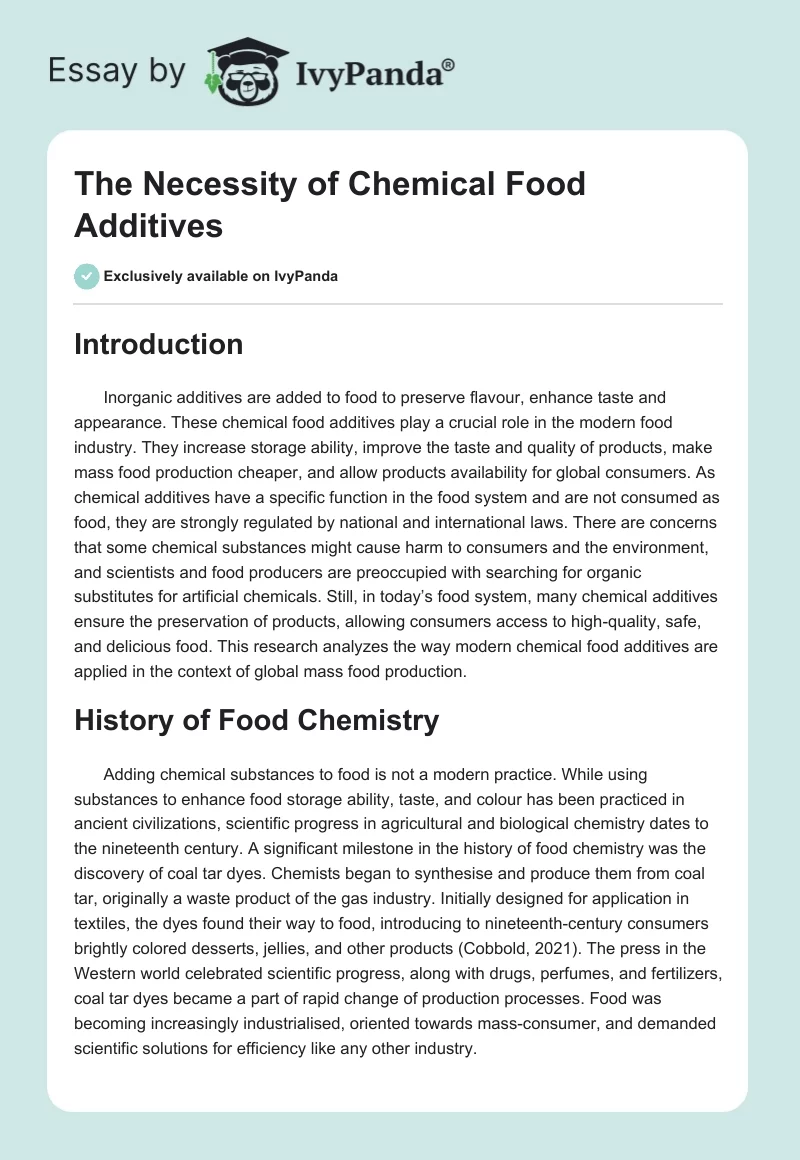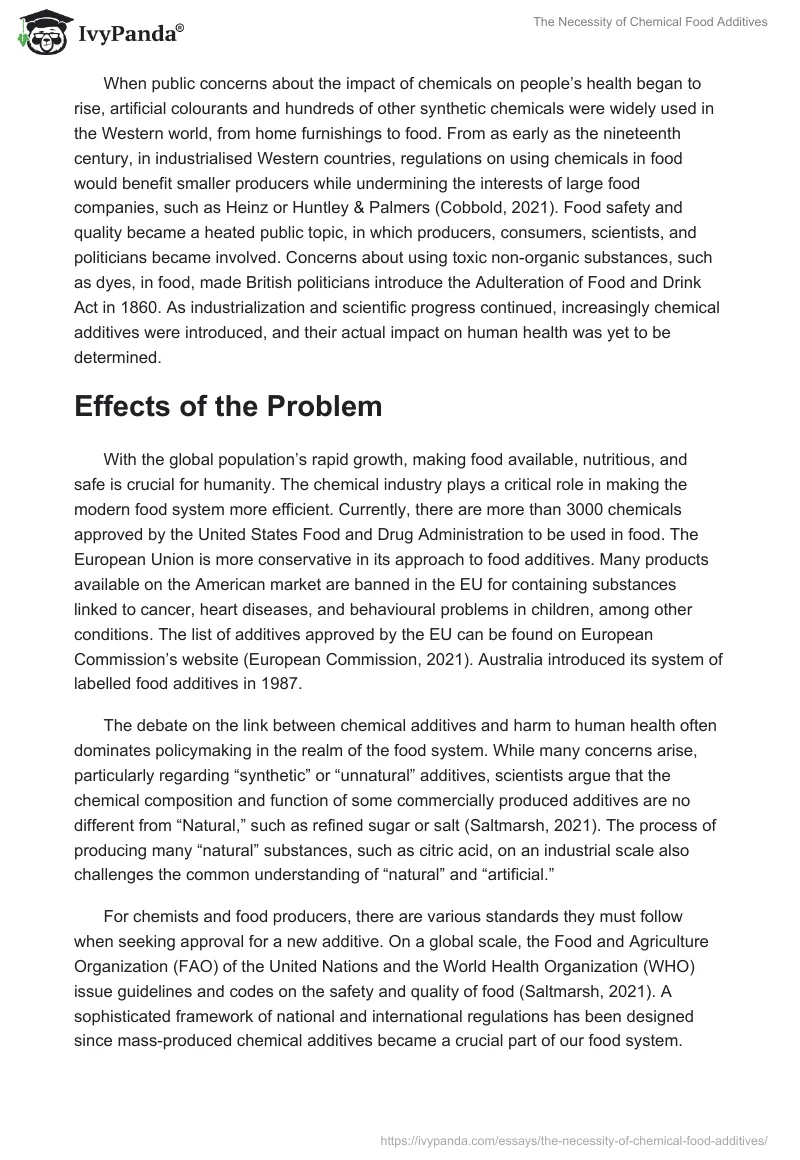Introduction
Inorganic additives are added to food to preserve flavour, enhance taste and appearance. These chemical food additives play a crucial role in the modern food industry. They increase storage ability, improve the taste and quality of products, make mass food production cheaper, and allow products availability for global consumers. As chemical additives have a specific function in the food system and are not consumed as food, they are strongly regulated by national and international laws. There are concerns that some chemical substances might cause harm to consumers and the environment, and scientists and food producers are preoccupied with searching for organic substitutes for artificial chemicals. Still, in today’s food system, many chemical additives ensure the preservation of products, allowing consumers access to high-quality, safe, and delicious food. This research analyzes the way modern chemical food additives are applied in the context of global mass food production.
History of Food Chemistry
Adding chemical substances to food is not a modern practice. While using substances to enhance food storage ability, taste, and colour has been practiced in ancient civilizations, scientific progress in agricultural and biological chemistry dates to the nineteenth century. A significant milestone in the history of food chemistry was the discovery of coal tar dyes. Chemists began to synthesise and produce them from coal tar, originally a waste product of the gas industry. Initially designed for application in textiles, the dyes found their way to food, introducing to nineteenth-century consumers brightly colored desserts, jellies, and other products (Cobbold, 2021). The press in the Western world celebrated scientific progress, along with drugs, perfumes, and fertilizers, coal tar dyes became a part of rapid change of production processes. Food was becoming increasingly industrialised, oriented towards mass-consumer, and demanded scientific solutions for efficiency like any other industry.
When public concerns about the impact of chemicals on people’s health began to rise, artificial colourants and hundreds of other synthetic chemicals were widely used in the Western world, from home furnishings to food. From as early as the nineteenth century, in industrialised Western countries, regulations on using chemicals in food would benefit smaller producers while undermining the interests of large food companies, such as Heinz or Huntley & Palmers (Cobbold, 2021). Food safety and quality became a heated public topic, in which producers, consumers, scientists, and politicians became involved. Concerns about using toxic non-organic substances, such as dyes, in food, made British politicians introduce the Adulteration of Food and Drink Act in 1860. As industrialization and scientific progress continued, increasingly chemical additives were introduced, and their actual impact on human health was yet to be determined.
Effects of the Problem
With the global population’s rapid growth, making food available, nutritious, and safe is crucial for humanity. The chemical industry plays a critical role in making the modern food system more efficient. Currently, there are more than 3000 chemicals approved by the United States Food and Drug Administration to be used in food. The European Union is more conservative in its approach to food additives. Many products available on the American market are banned in the EU for containing substances linked to cancer, heart diseases, and behavioural problems in children, among other conditions. The list of additives approved by the EU can be found on European Commission’s website (European Commission, 2021). Australia introduced its system of labelled food additives in 1987.
The debate on the link between chemical additives and harm to human health often dominates policymaking in the realm of the food system. While many concerns arise, particularly regarding “synthetic” or “unnatural” additives, scientists argue that the chemical composition and function of some commercially produced additives are no different from “Natural,” such as refined sugar or salt (Saltmarsh, 2021). The process of producing many “natural” substances, such as citric acid, on an industrial scale also challenges the common understanding of “natural” and “artificial.”
For chemists and food producers, there are various standards they must follow when seeking approval for a new additive. On a global scale, the Food and Agriculture Organization (FAO) of the United Nations and the World Health Organization (WHO) issue guidelines and codes on the safety and quality of food (Saltmarsh, 2021). A sophisticated framework of national and international regulations has been designed since mass-produced chemical additives became a crucial part of our food system.
Categories of Food Additives
In today’s global food industry, thousands of chemicals are added to products people around the world consume daily. As people’s eating habits change over time (for example, the growing consumption of processed foods as an alternative to homemade cooking), the world market for chemical food additives keeps thriving (Hendrich and Sachan, 2018). Thousands of industrially produced substances are added to food to improve its quality, alter taste qualities, and prevent rapid spoilage. Among these substances are chemicals that are well-known to today’s consumers and are added to most products available to consumers around the world. Ignoring the diversity of food additives undermines consumers’ understanding of why the substances are used in today’s food system. At the same time, transparency about ingredients’ origins contributes to public knowledge about healthy nutrition.
Among chemical additives used by food manufacturers today are acids, acidity regulators, anticaking agents, antioxidants, antifoaming agents, bulking agents, colourants, emulsifiers, flavouring agents, stabilizers, and preservatives. Thanks to these substances, consumers worldwide have access to a massive variety of delicious and safe products that do not get spoiled because of natural chemical reactions, such as oxidation. While many people assume “natural” or organic food tastes better, global consumers are more used to products with chemical substances in them in terms of taste and appearance (Saltmarsh, 2021). Mass production of such goods as yogurts, canned food, sauces, candy, and others would not be possible without these synthetic additives.
Chemical Additives and Safety Issues
A general concept of food safety includes three crucial aspects: traceability, food origins, and trustworthiness. Food origins have to be transparent in order to have a clear idea of the composition and proof that there are no pathogens, allergens, or other harmful elements. Chemical safety of products is a global issue that affects international trade and the public health of the world’s population. There are multiple ways how products can be contaminated by substances that can be harmful to people’s health. Environmental pollution is one of the ways how products (meat, fish, fruit, and vegetables) can be contaminated through water, air, or soil pollution (Kirchhelle, 2020). Usage of toxic chemicals in agriculture and veterinary drugs can also result in intentional or unintentional contamination of food. Food production, packaging, transportation, and storage are crucial for consumers’ safety in today’s food system.
Evaluation of risks chemicals are posing to food safety is at the core of the international scientific debate. Often, public concerns, heated by media, regarding the usage of chemical substances in food arise from the lack of basic knowledge about these substances and their purposes (Saltmarsh, 2021). While the amount of chemical additives in products is minor, their overall consumption is very significant. With the chemical industry rapidly developing, more and more substances and new ways to produce them become available, and each of them demands close attention regarding its impact on people’s health (Saltmarsh, 2021). Simultaneously, the public argument about “organic” foods being “healthy” and products with chemical additives being “unhealthy” often lacks scientific evidence, as many people still have limited knowledge about food production.
Conclusion
The chemical industry has changed people’s eating habits around the world. Ever since the nineteenth century, it has allowed the food industry to emerge and produce food on a mass scale. Artificial substances made most products accessible to people in the Western world, such as canned meat and vegetables, desserts, drinks, cooked meals, dairy products such as yogurts, and others. Chemical additives prevent products from rapid spoiling, change their taste and nutrition qualities. In today’s food system linked to international trade, the chemical industry plays a crucial role in production, packaging, transportation, and food storage.
Since the first synthetic colourants were applied in food production, the impact of chemical additives on people’s health has been at the core of the attention of politicians, scientists, food producers, and the press. With the rapidly developing chemical industry, more substances and ways of their synthesis become available. Simultaneously, their impact on people’s health is a subject of continuous systemic scientific observation. The substances allowed for usage in food production are monitored and approved by FAO and WHO.
Reference List
Cobbold, C. (2021) A rainbow palate: how chemical dyes changed the West’s relationship with food, Chicago: The University of Chicago Press.
Food Safety European Commission Database (2021) Web.
Hendrich, S. & Sachan, A. (2018) Food toxicology: current advances and future challenges, Toronto: Apple Academic Press.
Kirchhelle, C. (2020) Pyrrhic Progress: The history of antibiotics in Anglo-American food production, New Brunswick, NJ: Rutgers University Press.
Saltmarsh, Michael. (2021) Saltmarsh’s essential guide to food additives. Fifth edition. London, England: Royal Society of Chemistry.


